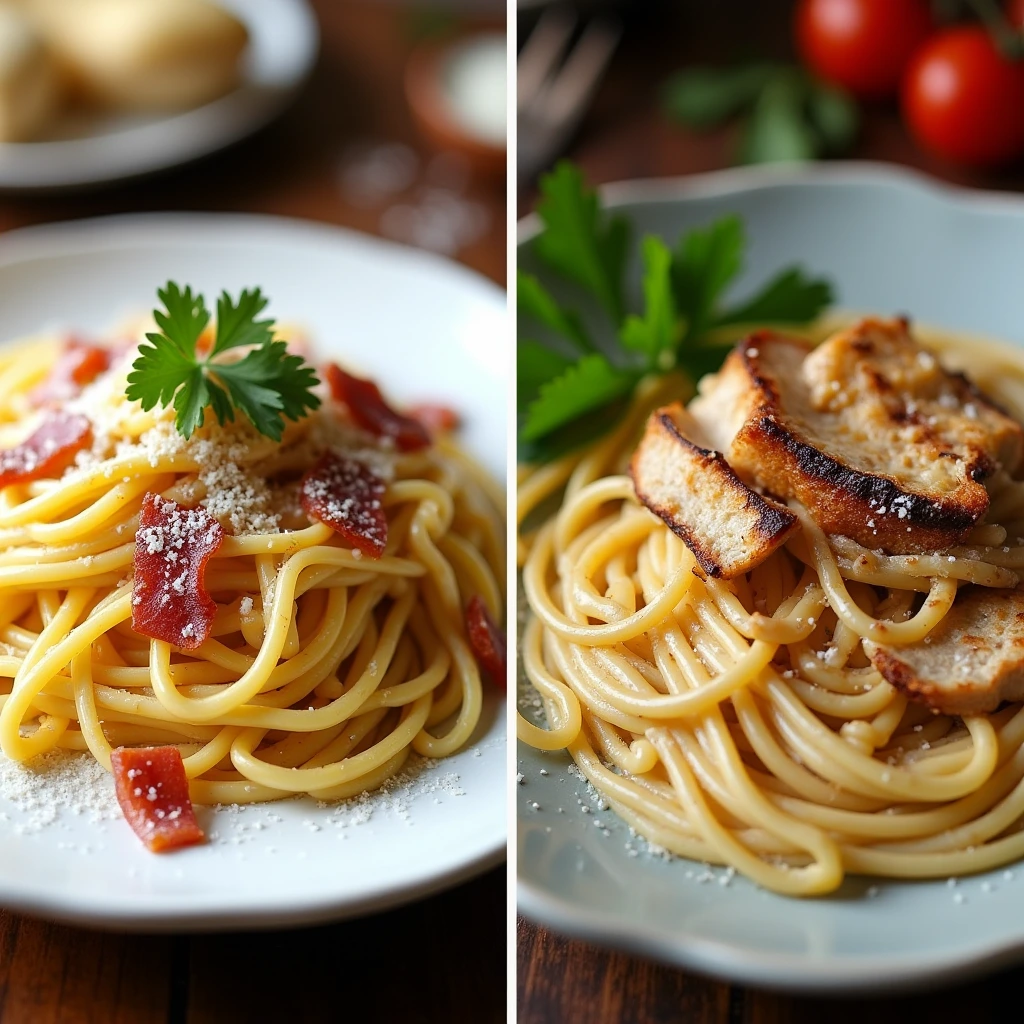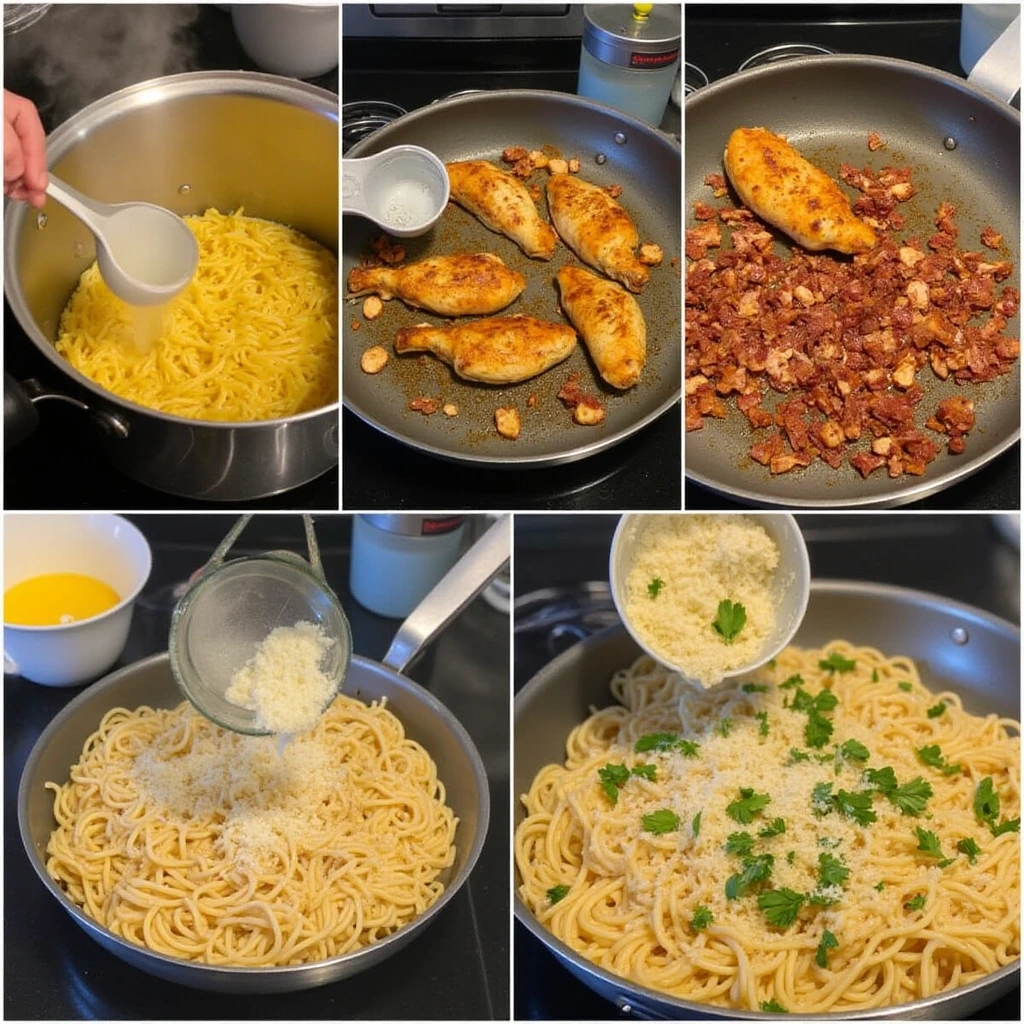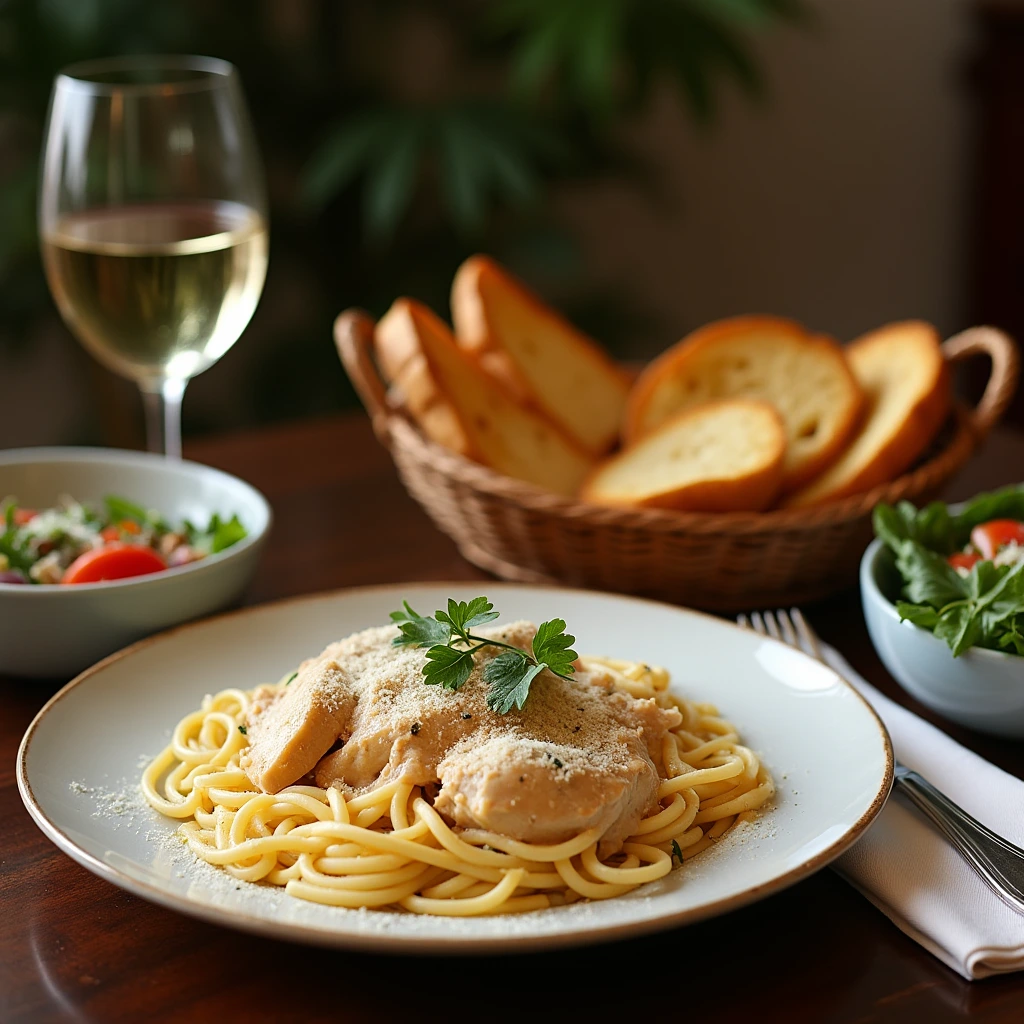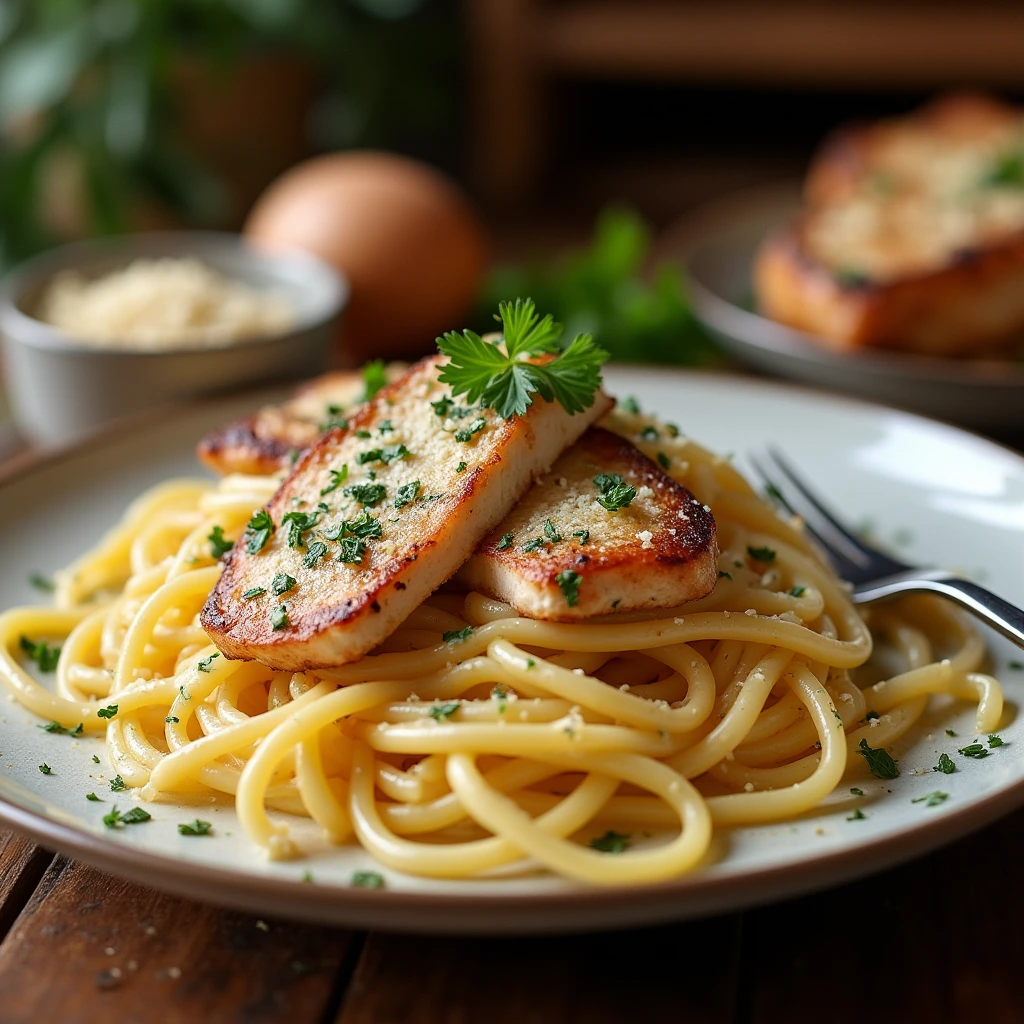Chicken carbonara is a comforting, creamy dish that adds a modern twist to the traditional Italian carbonara recipe. This updated version incorporates tender, juicy chicken, making it a hearty and satisfying meal that’s perfect for busy weeknights or special occasions. Whether you’re feeding your family or impressing guests at a dinner party, chicken carbonara is sure to be a hit. The dish is deceptively simple to prepare but delivers rich, complex flavors, making it an easy yet elegant choice for any meal. The silky texture of the sauce, combined with the smokiness of the pancetta and the tenderness of the chicken, creates a symphony of flavors that will leave everyone asking for seconds.
If you’re a fan of Italian cuisine and want to explore more ways to prepare carbonara, there are countless variations to try. Simply Recipes offers an excellent, easy-to-follow guide to classic chicken carbonara recipe, while Allrecipes has a creative recipe for a four-cheese version. Both sources offer different ways to experiment with the dish, allowing you to personalize it to your taste, whether you prefer a richer, creamier sauce or a more traditional approach. This flexibility makes chicken carbonara not only a delicious meal but also a versatile canvas for your culinary creativity.
What Makes Chicken Carbonara recipe Different from Classic Carbonara?
The classic Italian carbonara is a timeless dish that consists of pasta, eggs, cheese, and pancetta or guanciale, resulting in a rich, creamy sauce that perfectly coats the pasta. In this variation, chicken is added to the recipe, bringing an extra layer of flavor and protein to make the dish more filling. The chicken enhances the overall dish, providing a satisfying, savory element that contrasts with the richness of the egg-and-cheese sauce. For those who prefer poultry over pork, this version makes carbonara more accessible without sacrificing its traditional flavor profile.
One of the distinguishing features of carbonara is the use of eggs and cheese to create a creamy sauce, which is significantly lighter than the cream-based Alfredo sauce. The absence of cream in carbonara allows the other ingredients to shine, and the result is a smoother, silkier sauce that complements the pasta without feeling overly heavy. The balance of eggs, cheese, and pancetta or bacon in the carbonara sauce creates a velvety, indulgent coating that elevates the dish, making it a comforting but not overwhelming option for any occasion.
Additionally, if you’re looking to create a lighter version of chicken carbonara, there are several healthy swaps you can make. For instance, you can substitute the cream with Greek yogurt to retain a creamy texture without the added calories and fat. If you’re watching your gluten intake, using gluten-free pasta is an easy switch that still delivers on taste. Whether you prefer the traditional pancetta or a leaner protein like turkey bacon, there are many ways to adapt the dish to suit your dietary preferences.

Essential Ingredients for Chicken Carbonara
To make the perfect chicken carbonara, it’s important to gather all the right ingredients. While the basic recipe is simple, the quality of your ingredients plays a huge role in the final outcome. Below are the essential ingredients with quantities for this delicious dish:
- Pasta: 400g (14 oz) spaghetti (or your favorite pasta like fettuccine, penne, or linguine)
- Chicken: 2 boneless, skinless chicken breasts (about 500g / 1 lb), cut into bite-sized pieces
- Eggs: 3 large eggs (use only the yolks if you prefer a richer sauce)
- Cheese: 100g (1 cup) grated Parmesan or Pecorino Romano cheese
- Bacon or Pancetta: 150g (5 oz) pancetta or bacon, diced
- Garlic: 2 cloves, minced
- Olive Oil: 1 tablespoon (for cooking the chicken)
- Salt and Pepper: to taste
- Cream (Optional): 60ml (1/4 cup) heavy cream (optional for a creamier version)
- Fresh Parsley (Optional): for garnish
- Pasta Water: 1 cup (reserved from boiling the pasta)
Step-by-Step Guide to Making Chicken Carbonara
-
Cook the Pasta: Start by boiling your pasta in a large pot of salted water. Cook it until al dente, usually about 8-10 minutes, depending on the type of pasta you’re using. The pasta should be tender but still firm to the bite. Before draining, reserve about a cup of pasta water. This starchy water will be essential for adjusting the consistency of your sauce later.
-
Prepare the Chicken: While the pasta cooks, season the chicken breasts with salt and pepper. Heat the olive oil in a large skillet over medium-high heat. Cook the chicken until golden brown on the outside and fully cooked on the inside, about 5-7 minutes per side depending on thickness. Once cooked, remove the chicken from the skillet and set it aside to rest. Once it’s cool enough to handle, slice it into bite-sized pieces.
-
Cook the Pancetta: In the same skillet, add the pancetta (or bacon) and cook until crispy, about 3-4 minutes. This will render the fat and infuse the dish with a smoky, savory flavor. Be sure to keep an eye on the pancetta so it doesn’t burn. Once crispy, remove the pancetta from the skillet and set it aside, leaving the rendered fat in the pan for flavor.
-
Make the Sauce: In a bowl, whisk together the 3 eggs and grated Parmesan or Pecorino Romano cheese. Add a pinch of freshly ground black pepper to enhance the flavor. If you prefer a creamier version, stir in the heavy cream at this stage. Set the egg mixture aside.
-
Combine Everything: Once the pasta is ready and drained, return it to the pot or skillet over low heat. Add the cooked chicken and crispy pancetta. Pour the egg and cheese mixture over the pasta, then stir quickly and gently to combine the ingredients. The heat from the pasta and the skillet will cook the eggs, creating a creamy sauce. Add the reserved pasta water a little at a time to achieve the perfect creamy consistency. If you prefer a thicker sauce, use less pasta water; for a thinner sauce, add more.
-
Final Touches: Taste the dish and adjust the seasoning with more salt, pepper, or grated cheese if needed. Serve immediately, garnished with fresh parsley if desired.

Tips for Avoiding Curdling
To ensure your sauce comes out perfectly creamy without curdling, follow these tips:
- Remove the skillet from the heat: Before adding the egg mixture, take the pan off the heat. The residual heat from the pasta will cook the eggs gently, creating a smooth sauce.
- Stir continuously: Stirring quickly but gently will help incorporate the eggs with the pasta, creating a uniform sauce and preventing any clumps from forming.
Variations of Chicken Carbonara
While the classic chicken carbonara is delightful, there are many variations that you can try based on your taste preferences:
- Classic Chicken Carbonara: This version sticks to the essential ingredients—pasta, chicken, eggs, cheese, and pancetta. It’s simple but delicious.
- Creamy Chicken Carbonara: For a richer version, add a bit of heavy cream to the egg mixture to make the sauce extra creamy. This version is similar to Alfredo but retains the signature carbonara flavor.
- Healthy Chicken Carbonara: To make the dish lighter, opt for whole-grain pasta, use turkey bacon instead of pancetta, and add fresh greens like spinach or kale for a boost of nutrients.
- Vegetable-Loaded Carbonara: Add sautéed mushrooms, roasted broccoli, or sun-dried tomatoes to your carbonara for a flavorful twist that adds color and texture.
Sure! Here’s a section on the nutritional value of the Chicken Carbonara recipe:
Nutritional Value of Chicken Carbonara Recipe
Chicken carbonara is a deliciously indulgent dish, but it’s important to understand the nutritional content to ensure it fits your dietary goals. This recipe combines rich ingredients like chicken, eggs, cheese, and pancetta, which provide a balanced mix of protein, fats, and carbohydrates. Below is an estimate of the nutritional breakdown for a standard serving of chicken carbonara, based on a typical recipe that serves 4.
Per Serving (approximate):
- Calories: 600-700 kcal
- Protein: 35-40g
- Fat: 25-30g
- Saturated Fat: 8-10g
- Carbohydrates: 65-75g
- Fiber: 3-5g
- Sugars: 3-5g
- Cholesterol: 210-230mg
- Sodium: 700-800mg
- Calcium: 200-250mg
- Iron: 2-3mg
Key Nutritional Insights:
- Protein: Chicken is an excellent source of lean protein, and this dish provides a substantial amount of protein per serving, making it a great choice for muscle repair and maintenance. The eggs and pancetta also contribute to the overall protein content, adding a satisfying quality to the dish.
- Fat: The fats in this dish come from a combination of olive oil, chicken, cheese, and pancetta. While some of these fats are healthy monounsaturated fats (from olive oil and chicken), the dish also contains saturated fats from the cheese and pancetta. For those looking to reduce fat intake, turkey bacon or leaner cuts of chicken can be used as substitutes.
- Carbohydrates: The primary source of carbs in chicken carbonara is the pasta. While the dish provides a moderate amount of carbohydrates, you can make it even healthier by opting for whole-grain pasta, which adds fiber and essential nutrients like B vitamins.
- Cholesterol & Sodium: The dish contains a fair amount of cholesterol due to the eggs and pancetta, as well as sodium from the pancetta and cheese. If you’re concerned about cholesterol or sodium intake, consider using reduced-sodium pancetta or omitting it entirely, and reduce the amount of cheese.
- Calcium and Iron: The Parmesan or Pecorino Romano cheese contributes calcium, which is essential for bone health, while the iron content in the chicken and pasta provides benefits for blood health.
How to Make It Healthier:
- Lower the Calories: To make the dish lighter, you can reduce the amount of cheese or use a lower-fat cheese like part-skim mozzarella or a reduced-fat Parmesan. You could also skip the cream or reduce the portion size of pasta.
- Increase Fiber: Swap traditional pasta for whole-grain or gluten-free pasta, which will increase the fiber content and make the meal more filling. You could also add vegetables like spinach, peas, or roasted tomatoes to increase the fiber and antioxidant content of the dish.
- Cutting Down on Fat: Substitute pancetta or bacon with turkey bacon or omit it entirely for a leaner dish. Using grilled chicken without the skin further reduces fat intake.
Overall Summary:
Chicken carbonara, while indulgent, can be a balanced meal with plenty of protein and a rich, satisfying flavor profile. By tweaking a few ingredients or portion sizes, it’s possible to make it lighter or fit specific dietary needs, whether you’re aiming to reduce fat, sodium, or calories. The dish offers a good mix of macronutrients, but it should be enjoyed in moderation due to its calorie and fat content, especially if you’re watching your weight or cholesterol levels.
Serving Suggestions and Pairings
To complement the rich and creamy chicken carbonara, try pairing it with these side dishes:
- Salad: A crisp, refreshing salad with a tangy vinaigrette provides a nice contrast to the creamy pasta. Arugula, spinach, or mixed greens work well.
- Garlic Bread: Serve alongside warm, crusty garlic bread to soak up the delicious sauce. The crunchy texture pairs perfectly with the creamy pasta.
- Wine: A glass of white wine, such as a crisp Pinot Grigio or a buttery Chardonnay, will complement the richness of the carbonara sauce.

FAQs About Chicken Carbonara
- What’s the Difference Between Carbonara and Alfredo?
Carbonara uses eggs and cheese to create its creamy texture, while Alfredo relies on butter and cream. This makes carbonara a lighter yet just as indulgent option. - Can I Make Chicken Carbonara Ahead of Time?
While you can prepare the chicken and sauce in advance, it’s best to cook the pasta fresh to avoid it becoming too soft. Combine everything just before serving for the best texture. - What Type of Pasta Is Best for Carbonara?
Spaghetti is the most traditional choice, but fettuccine, linguine, or even penne also work well. The important thing is to choose pasta that can hold the sauce. - How Do I Prevent the Eggs from Scrambling in Carbonara?
To avoid scrambled eggs, remove the pan from heat before adding the egg mixture. Stir gently and continuously to create a smooth sauce.
Conclusion
Chicken carbonara is the perfect dish for anyone craving rich, comforting food with a modern twist. By combining tender chicken with the classic flavors of pancetta, eggs, and cheese, you get a dish that is both
indulgent and satisfying. Whether you stick to the traditional recipe or try a variation, chicken carbonara is guaranteed to impress. With its simple ingredients and creamy sauce, it’s a dish that can be easily customized to suit any occasion or dietary preference. So, grab your ingredients, get cooking, and enjoy this delicious Italian comfort food!
